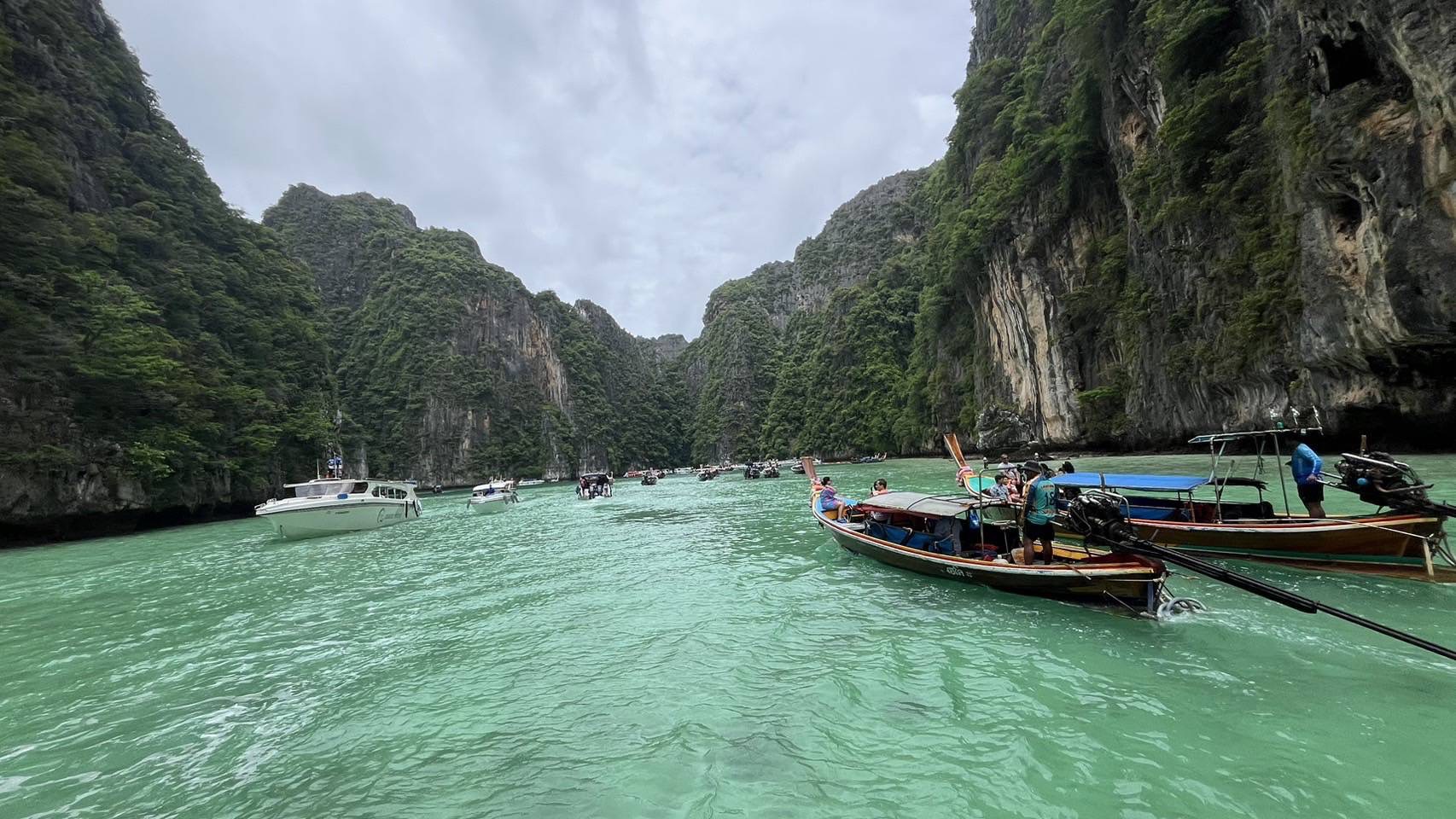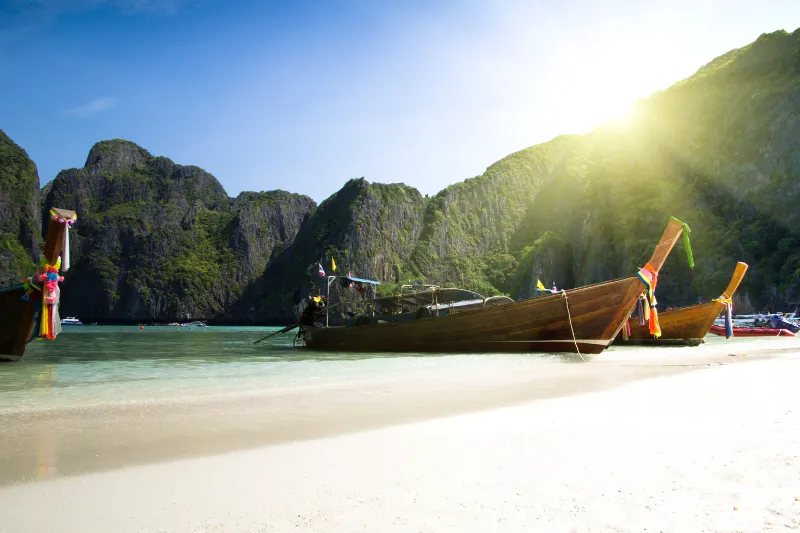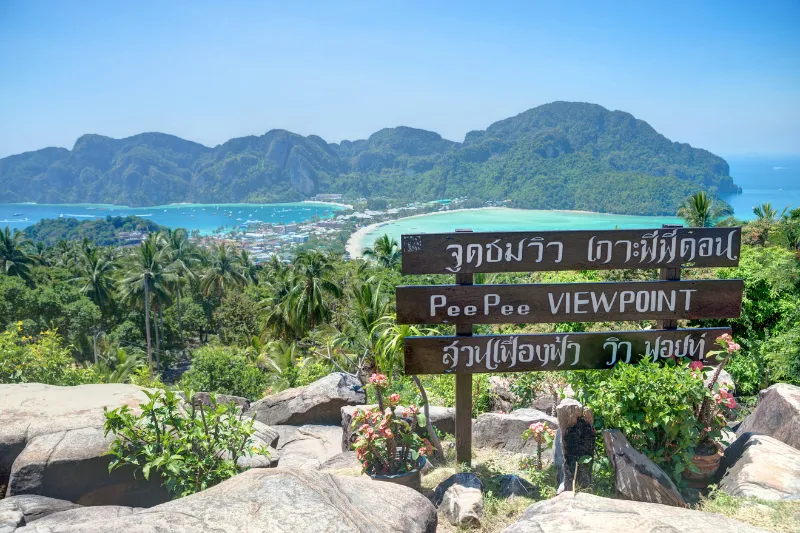


Maya Bay : The History of the Beach Famous from the Movie
Maya Bay : The History of the Beach Famous from the Movie
Maya Bay, located on Koh Phi Phi Leh in Thailand, is one of the most iconic and stunning beaches in the world. Its fame skyrocketed in the year 2000 when it was featured in the critically acclaimed film The Beach, starring Leonardo DiCaprio. This picturesque bay, with its crystal-clear turquoise waters, dramatic limestone cliffs, and white sandy beach, became an instant symbol of tropical paradise. But there’s more to this incredible destination than just its film fame. Let’s take a deeper look at the history and allure of Maya Bay, its cultural significance, and its impact on tourism.
1. The Discovery of Maya Bay: Natural Beauty Long Before the Movie
Maya Bay, part of Phi Phi Islands, is located in the Andaman Sea, about 45 minutes by boat from Koh Phi Phi Don, the largest island in the group. For many years, the bay was a quiet, hidden gem known mostly to locals and seasoned travelers.
The Formation of the Bay
Maya Bay is surrounded by 100-meter-high cliffs on three sides, with a narrow entrance to the sea. The bay is protected from strong winds, making the waters calm and inviting. The area is rich in marine life, including coral reefs and a variety of fish species. The surrounding cliffs and lush vegetation add to the bay’s dramatic natural beauty.
2. The Beach: Maya Bay’s Rise to Global Fame
The turning point for Maya Bay came in 2000, when it was chosen as the primary filming location for Danny Boyle’s film “The Beach.” The movie, based on the novel by Alex Garland, tells the story of a young traveler (played by Leonardo DiCaprio) who seeks out a secluded island paradise.
The Impact of the Film
The picturesque scenes of Maya Bay, with its pristine beach surrounded by towering cliffs, quickly captured the attention of global audiences. The natural beauty showcased in The Beach made Maya Bay an instant tourist hotspot. Within a few years, the beach transformed from a relatively quiet location to one of the most visited beaches in Thailand.
3. The Environmental Impact of Tourism
While the movie brought global recognition to Maya Bay, it also led to an overwhelming influx of tourists. Over the years, the number of visitors to the bay has soared, significantly affecting the delicate environment.
Overcrowding and Damage to Marine Life
The large number of tourists flocking to Maya Bay created environmental challenges, including:
Coral damage: The reefs around Maya Bay were severely affected by the increase in boat traffic, as well as activities like snorkeling and diving.
Waste management: With the rise in tourism, littering and waste disposal became major concerns for local authorities.
Erosion of the beach: The constant foot traffic caused significant damage to the shoreline and disrupted the natural habitat.
To protect the natural resources and restore the ecosystem, Thailand’s authorities made the difficult decision to temporarily close Maya Bay in 2018 for rehabilitation.
4. The Conservation Efforts and Revival of Maya Bay
In response to the environmental damage, the Thai government decided to close Maya Bay for an indefinite period starting in 2018. The closure allowed the local ecosystem, particularly the coral reefs, to recover and regenerate. During this time, tourism was strictly regulated, and all boats were prohibited from entering the bay.
Rehabilitation Measures
Marine life restoration: Efforts have been made to revive coral reefs, and a study of the marine ecosystem is being conducted to understand its restoration needs.
Restricted access: Limited visitor access has been introduced, and tourism is closely regulated.
Ecotourism initiatives: The government and local stakeholders are promoting sustainable tourism practices to ensure that future visitors can enjoy the bay without harming its delicate ecosystem.
5. Maya Bay Today: A Protected Paradise
As of 2022, Maya Bay has officially reopened to the public, but with strict regulations in place. Now, visitors can experience the beauty of this world-famous beach once again, but under controlled conditions to prevent further environmental damage.
What Has Changed
Limited boat traffic: Only certain boats are allowed to enter the bay, and only a limited number of tourists are allowed on the beach at any given time.
No swimming allowed: To protect the marine life, swimming in the bay is prohibited.
Eco-friendly tourism: Sustainable practices are now emphasized, and tourists are encouraged to respect the natural beauty of the area.
6. The Future of Maya Bay: Balancing Tourism and Conservation
The future of Maya Bay rests on maintaining the balance between tourism and environmental conservation. As one of the most iconic beaches in the world, its continued popularity poses challenges, but it also offers opportunities for sustainable tourism.
Key Challenges
Balancing economic growth and environmental conservation: While tourism brings revenue, it is essential to ensure that the ecosystem is not harmed by over-tourism.
Raising awareness: Educating visitors about the importance of conservation and encouraging responsible behavior is key to preserving the bay.
Potential for Ecotourism
Maya Bay has the potential to be a model for ecotourism in Thailand and beyond, where visitors can experience nature’s beauty while supporting conservation efforts. By promoting responsible tourism and sustainable practices, it’s possible to protect the environment while still allowing people to enjoy the bay’s natural wonders.
7. Conclusion
Maya Bay, a hidden paradise for many years, became a global icon after being featured in The Beach. However, with the surge in tourism came significant environmental challenges. Thanks to conservation efforts, the bay is now on the road to recovery, and visitors can once again experience its stunning beauty in a sustainable way.
As Maya Bay reopens, it serves as a reminder that balancing tourism with conservation is crucial. By respecting the natural environment and adhering to guidelines, we can ensure that this beautiful paradise remains a treasure for future generations to enjoy.

